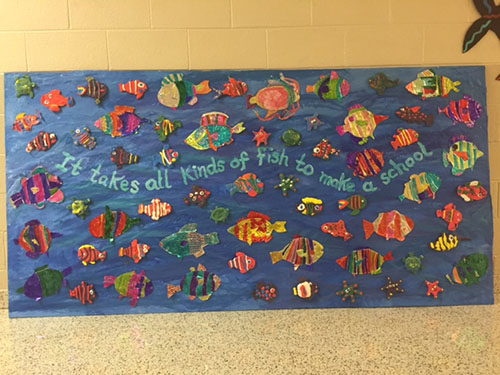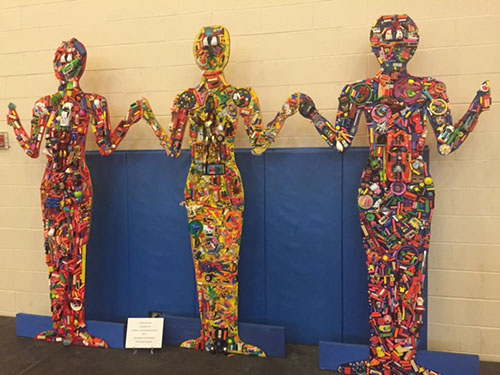Arts education provides students with a sense of personal worth and fosters an appreciation for creativity and innovation. Education specialists across the county agree that effective arts education promotes self-directed learning, sharpens critical thinking skills, develops self- awareness, improves school attendance, and encourages positive behavior! These are just a few of the reasons we have developed education outreach programs like Art to Go. Working in partnership with Charleston County School District Title I schools, Art to Go combines art making and instruction through experiences with real works of art. Gibbes Teaching Artists work with art teachers in six schools on a specific project or to complement their curriculum. Each year Art to Go collaborates with the Charleston Marathon, which benefits the Youth Endowment for the Arts. Completed projects were on display at the Marathon Expo in January.

Each year the Art to Go grows in strength and numbers! We asked each of the four art teachers to share a few words with us about their experience in the classroom. Sally Collins, a long time Gibbes teaching artist, was not available for an interview, but you can see her student’s work pictured below.

Q. How many years have you been involved in Art to Go and how do you decide on your project each year?
Kristen: This was my third year working with Art to Go. Each year I try to plan a project that is inclusive to all ages, while also using different art forms and mediums. This year we created a large paper mache Angel Oak tree sculpture. This was the first time many of the students had created such a large work, used paper mache, and made a sculpture. The students took pride in the assembly of the tree and helped each other apply the wet sheets of paper around our wire frame to build the tree. Fourth and fifth graders tied and cut out leaves, work that required a lot of patience and detail. Each week the classes would come in to check the tree’s progress to see it go from a wire frame to a wet paper mache base to a fully painted trunk to then being full of branches and leaves.

Leonora:
I have been involved in Art to Go twice, once in 2012 and again this year. I decided on the concept for the projects based on what grades I’d be working with, what materials were available, and what the kids would benefit from. For example, the first year we created a clay mosaic because I had access to a kiln for firing the clay. This year, we also made a mural but instead we used a mix of different materials, such as paper, paint, aluminum foil, and model magic clay. I made sure to use materials the students normally didn’t work with or worked with rarely, so that they could learn something new.
Hannah:
This was my first year with the program! I researched different ideas, and met with my teachers a few weeks before class to discuss what their thoughts were. The projects ended up being collaborative ideas between what we thought would be really fun, but also informative.
Q. Tell me about your student’s experiences with art. What do you hope they walk away with or remember about creating art?
Kristen:
From my experience it seems that art class is one of the opportunities that students look forward to most. It is the opportunity to learn new mediums, work with your hands, and a place where all skill levels are welcome because uniqueness is encouraged.
Leonora:
I think what my students remember the most from their experience is the joy of using materials they have never used and exploring those materials with a sense of excitement and curiosity. I think it’s special for them to have a guest come in to their art room and this excitement carries over to their art making. I think art is primarily about having fun and expressing one’s creativity, and if we achieved that, I think that’s the most important goal. The other thing my students took away from it was an exposure to the Gibbes Museum and their connection to the history and art of Charleston, which is so important for them.
Hannah:
I hope that they hold on to the feeling that comes with creating something that you’re really proud of.
Q: How do you think art enhances education?
Kristen:
Art enhances education in countless ways. Through these projects I can see first-hand how art teaches not only new skills and techniques for making art, but also how to work as a team, problem solve, and be creative.
Leonora:
Art, unlike many other subjects, gives the children an opportunity to use their hands and develop their fine motor skills, which is important to have in any future career. Also, art gives children an opportunity to expand and practice using their creativity and imagination. Without creativity, I don’t think you could be a good scientist. Also, art gives students a chance to relax, have fun, and unwind from a day that may be filled with stress. I noticed that when the kids worked with clay in the art room, they were relaxed when molding the clay. I think art has a therapeutic effect in children and can relieve stress, which allows them to focus more on other subjects.
Hannah:
Art helps people express themselves in a way that’s different than other educational activities. Instead of writing something down, or acting something out, kids are given the opportunity to physically create something that’s completely their own. That’s an accomplishment in itself, and I think it helps build a sense of confidence and self-worth.
Bios:
Kristen Solecki is an illustrator and art educator that uses paint and ink to translate stories and moments using strong changeable line work and bold color. She has created work for publications such as Taproot Magazine, Uppercase Magazine, Skirt Magazine, the television show, Mad Men, as well as for galleries and shops across the U.S. You can see her work at www.kristensolecki.com
Leonora Dechtiar has her BFA in Illustration from Maine College of Art and her Masters of Arts in Teaching from Savannah College of Art and Design. She studied art for a semester in Spain, where she developed a deep appreciation for art history. She loves illustrating for children, and has published with Studio 9, Inc., which publishes educational materials and coloring books for children. After getting her certificate in art education, Leonora has worked as an art teacher at the Gibbes Museum of Art in Charleston, SC for two years. She also spent a year and a half in Beijing, China teaching art at an international Montessori school.
Hannah Durant grew up in Alexandria, VA and went to college at Elon University. After she graduated, she moved back to Virginia to get a “real” job and quickly realized that wasn’t her path. Hannah has spent the last two years in Charleston, SC working with creative businesses in different capacities, and building on her interests.
Sally Collins holds a Commercial Art Degree, Bachelor of Social Science Degree, and Master in Teaching (MIT) Degree. She has previously taught Art, English, and 4th grade at the First Baptist School in Mt. Pleasant, 1st and 3rd grade at Midland Park Elementary in Charleston County as well as Art at Trident Academy in Mt. Pleasant. She has served as a Gibbes Teaching Artist for over 5 years with experience in summer camp, after school classes as well as Art to Go.
Published February 6, 2015


